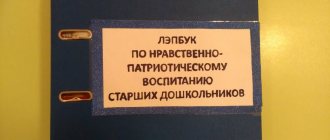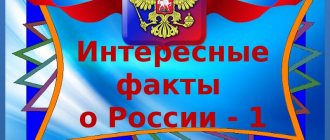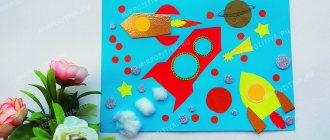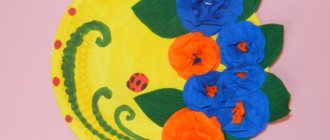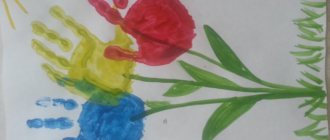One of the youngest public holidays is Russia Day, which is celebrated on June 12. On this holiday, mass celebrations, concert programs, fairs and exhibitions of children's creativity are organized throughout the country.
Would you like to participate in one of these holiday exhibitions? Then you can’t do without a great idea for a themed craft for Russia Day.
In this article, we have prepared for you several interesting crafts for Russia Day that you can make with your own hands. You will also find on our page several interesting video master classes on the same topic.
So, let's begin!
Moscow is capital of Russia
Moscow is the capital of our state, the main city of Russia. The exact date of the founding of the city is not known, but Moscow was first mentioned in the Ipatiev Chronicle for 1147. That year, the Suzdal prince Yuri Dolgoruky invited the Chernigov prince Svyatoslav Olegovich to his estate, which was believed to be located on the hill where the Kremlin now stands. From 1922 to 1991 - the capital of the Union of Soviet Socialist Republics.
The Kremlin is a symbol of Moscow
The Moscow Kremlin is called the heart of Moscow. It is located on the banks of the Moscow River, in the very center of the city. The Kremlin, the symbol of Moscow, is a magnificent ensemble that unites architectural monuments from different eras, surrounded by brick walls, above which 20 towers rise. The Kremlin houses government institutions, ancient palaces and temples. You can walk along the Kremlin walls here. By the way, once it was almost blown up - you can find out more in this article.
Red Square is a symbol of Moscow
Red Square is the main square of Russia. Military parades and the main celebrations of the country take place here. There are a lot of interesting cultural monuments and attractions on Red Square. The most famous of them are the Mausoleum of V.I. Lenin, Execution Place, St. Basil's Cathedral, as well as the Upper and Middle shopping arcades, Kazan Cathedral. In addition, to the west is the Moscow Kremlin
Conclusion
As a result of my small research on the topic “Russia - My Motherland,” I learned a lot of new things about our country. I saw how vast, diverse, beautiful and interesting our Russia is. I will definitely be traveling a lot. I will continue to study the peculiarities of our country. I really want to learn as much as possible about our great country, Russia. I consider myself a patriot of my Fatherland.
Patriotism is an important moral quality that manifests itself in love for the small Motherland and the country as a whole. Without patriotism, a person will not respect the Motherland, society and his loved ones.
Collective work “Russia is my Motherland!” Master Class
Irina Evgenievna Parieva
Collective work “Russia is my Motherland!” Master Class
Let's remember the words from the song:
“For me, Russia is white birches ,
For me , Russia is morning dew .
For me, Russia , you are the most precious thing,
How much you look like my mother.”
In preparation for the upcoming holiday, the guys and I decided to do the following work :
For a Russian person there is no tree dearer and dearer than the birch. Ask anyone, is there a tree in Russia to which poets would devote so many poems, and people - songs? Perhaps this is because the white birch tree evokes in us feelings consonant with the generous and responsive Russian soul!
The sun warmed the slopes a little and it became warmer in the forest,
The birch tree hung its green braids from its thin branches.
All dressed in a white dress, earrings, lace foliage
She meets the hot summer at the edge of the forest.
We talked a lot about this with the children, so we decided to depict in our work a hot, gentle sun, a stunningly slender birch tree and many, many bright fragrant flowers. We started our work , of course, by creating a background. For the main background we used beige corrugated paper, and for the future flowering meadow we used green:
First we decided to make flowers. The children chose the technique themselves, the general decision was made like this: from corrugated paper, cut into small rectangles (the corners are cut off, the parts are twisted in the middle, two petals are obtained at once, a flower is formed from 3 of them):
Already during the work , the idea came to make a flower meadow in the form of a tricolor. The middle was made of yellow paper.
And then beautiful birch trees appeared in our picture: we made the crowns from green corrugated cardboard, and the trunks from white paper tubes.
How to make a craft on the theme of my homeland
And we will make a flag!
The first craft is made using the applique technique. Draw an outline of the flag on a piece of white paper. Then tear colored paper of red, blue, white and brown into small pieces. Glue the segments to the drawn sketch, thereby decorating the flag.
To make such a voluminous flag, you will need blank paper or corrugated paper. Cut the paper into small squares. Draw a silhouette of a flag on a piece of paper. Fill in the design with crumpled paper squares, securing them with glue.
You can make very cool and original flag-themed crafts if you use pasta as a material at hand. Pasta can be painted beautifully in any color, which means you can create a variety of images from it.
The fastest way to make a craft for Russian Flag Day is to draw a flag on a sheet of white paper with watercolors or gouache.
Three-dimensional flags can be made by gluing colored paper loops onto a rectangular sheet of cardboard.
A flag made from children's hands looks very unusual and original. Trace children's hands on colored paper or any other decorative paper, and then glue them to a sheet of thick cardboard.
A flag made of satin ribbons looks elegant and neat. Be sure to place your craft in a frame.
The flag can also be made from paper flowers glued to a sheet of Whatman paper. Add a couple of white doves to make the craft look even more impressive.
Any materials are suitable for making crafts. For example, you can use broken tiles.
Craftswomen will love the idea of making crafts on the theme of Russian Flag Day from shiny sequins.
Or maybe you know how to crochet or knit well? Then go for it!
Pieces of plasticine stuck to a sheet of cardboard create a voluminous and interesting craft.
Everyone knows the exquisite quilling technique. Why not use it when creating crafts on this topic. The finished work can become an independent panel or a decoration for a greeting card or poster.
Very beautiful and neat bead work.
And finally the most creative one – a cardboard puzzle. Draw a flag on rectangular cardboard using paints. And then cut it into pieces like a puzzle.
Source
Application for Russia Day: Russian nature and tricolor
Let's look at how to make a bright solar applique for the summer holiday - Russia Day, which our country will celebrate on June 12. This is an option for children, for kindergarten and for schoolchildren. The applique depicts Russian motifs: white birch trees that stand modestly in a field, and a sea of flowers, and the shades of the flowers are chosen to imitate the Russian tricolor.
You can decorate the applique in any available way, for example, using all kinds of pictures from children's albums, old magazines, and so on.
Application for Russia Day: Russian nature and tricolor
To make a festive applique, prepare:
- a set of colored paper;
- golden foil;
- scissors;
- glue;
- black gel pen;
- a figured hole punch in the shape of a flower of small diameter;
- pictures of butterflies, birds, and other insects.
How to make an applique for Russia Day step by step
Take the necessary materials for work and prepare a bright sheet for the background. For example, you can use a beautiful yellow color, and thus the landscape you depict will be shown in a sunny meadow. To quickly create a large number of small flowers, it is convenient to use a special shaped hole punch.
Craft materials
Cut out a circle from gold foil and stick it in the upper corner of the applique. It will be bright sunshine.
Sun
Cut long strips of white paper about 3 cm wide.
Long stripes
Bend each strip lengthwise twice so as to obtain a three-dimensional birch tree trunk. These trunks must be thin. Also cut out the wavy contours of the tree crowns from green paper.
Trunk and crown
Start attaching the trees to the prepared rectangular base. Attach the green crown first, and then attach the trunks in the center.
Glue the trunk and crown
On each white birch trunk you need to draw characteristic dots with a black gel pen or felt-tip pen. Also, cut out additional wavy parts from green paper that imitate branches and glue them in the foreground.
Branches and trunk pattern
In the same way, assemble the second and third trees that will fit in the picture.
Second and third tree
Don't forget to design the trunks in a distinctive way and add green crown details to the front.
Trunks and crowns
Using a shaped hole punch, create 3 portions of small flowers in white, red and blue. These flowers will not only decorate the applique, but will also create an imitation of the tricolor, since it is planned to create a holiday craft. To make the flowers look voluminous, press each of them against the rounded part of the handle and curl it a little.
Flowers
Attach the flowers in a row. First fill in the red bar.
Forming a red stripe of flowers
Glue all the red flowers, trying to make an even line out of them.
Forming a straight line
Directly above the red stripe, attach a blue one and then a white one. Thus, a flower meadow will be imitated and the craft will be decorated.
Glue blue and white stripes
You can cut out a small cloud from blue paper and cover the sun with it, and also add butterflies, birds, and so on to the applique. A beautiful craft for Russia Day is ready.
Beautiful craft for Russia Day
State symbols of Russia
The state symbols of any country include the coat of arms, flag and anthem. This triad did not arise immediately. It was only in the 20th century that a mandatory tradition was established throughout the world - each country to have its own coat of arms, flag and anthem.
Residents of different countries are rightfully proud of their symbols. The attitude towards the coat of arms, flag and anthem is the attitude towards the state itself. And it must be respectful. The symbols of our Motherland date back hundreds of years. The first state emblem appeared at the end of the 15th century, the first flag - in the 18th century, and the first anthem - in the 19th century. But more on that later.
Coat of arms of the Russian Federation
The word “coat of arms” came into Russian in the 16th – 17th centuries. It is based on the German erbe, which means “inheritance.” So the word itself contains one of the important features of the coat of arms - stability, constancy in use.
The state emblem testifies to the sovereignty of the country, the family coat of arms indicates that its owner belongs to a certain class. A coat of arms can indicate land holdings, like many family coats of arms of the Middle Ages, and serve as a means of identifying its owner. Therefore, the coat of arms, as a rule, is officially approved by the highest authority.
the emblem of the double-headed eagle in Russia come from ?
Initially, historians thought that Rus' borrowed it from Byzantium. As a sign of the imperial court, the double-headed eagle adorned the fabrics, clothing and shoes of emperors and courtiers. This emblem became especially popular under the emperors of the Palaiologos dynasty.
Perhaps the double-headed eagle was their family emblem. His image can be seen on the handwritten Gospel that belonged to Dmitry Paleologus. In Rome, the eagle has been revered since ancient times. According to legend, it was the eagle, this messenger of the gods, who predicted the acquisition of royal power by Tarquin the Ancient. The prevalence of the double-headed eagle emblem in the Balkans led scientists to believe that it was from this region that the eagle could have come to Rus'.
But, the most interesting thing is that the double-headed eagle was also found in Rus' itself, and long before 1497. The double-headed eagle was intended to symbolize the power and independence of our country. In this capacity, he continued his history on Russian soil.
In the 16th – 17th centuries. In the Moscow kingdom, two state seals were used - the Great and the Small. They differed in size, placement of emblems and inscriptions, but both retained images of a horseman and a double-headed eagle. On the Great State Seal, the rider was placed on the chest of a double-headed eagle. On the Small Seal, a horseman and an eagle were depicted on both sides.
At the end of the 1530s. the double-headed eagle acquired a more warlike appearance; they began to depict Him with open beaks and protruding tongues. In heraldry, such an emblem is called an armed eagle.
On the seal of False Dmitry I, the eagle is depicted with raised wings, and above its heads there are two crowns, between which there is a third, larger one. On the seals of Tsar Mikhail Fedorovich, the eagle's wings were lowered, and three crowns were placed above the eagle's heads.
In the first half of the 19th century. The image of the Russian coat of arms has changed again. Two types of state emblem arose. In the first, an eagle with outstretched wings held the Moscow coat of arms on its chest in a shield of an elegant, pointed upward shape.
A crown was placed above the eagle's heads. This eagle sometimes held a bunch of lightning bolts and a torch in its paws, and a laurel wreath in the other. The second type of coat of arms is an eagle with raised wings, crowned with three crowns. The shield with the Moscow coat of arms on his chest was framed by the chain of the Order of St. Andrew the First-Called.
And on the eagle’s wings there are 6 shields with the coats of arms of the most important lands, the names of which were included in the imperial title. The last change to the state emblem in the pre-revolutionary period took place in 1882 - 1883.
Alexander III accepted the Large, Middle and two Small coats of arms made by the artist A.I. Charlemagne. The presence of three types of state coat of arms is explained by the fact that they were depicted on seals that sealed documents of different significance.
The revival of the Russian state entailed the inevitable return of the original Russian symbols, so recklessly consigned to oblivion during the Soviet period. The history of the creation of the coat of arms is enormous. Symbols are nameless, they do not know their authorship, they are created by history itself.
In 1917, the eagle ceased to be the coat of arms of Russia. The return of the double-headed eagle to the coat of arms of Russia took place in 1993 by Decree of the President of the Russian Federation dated October 30, 1993. The author of the sketch of the coat of arms is the artist of the State Heraldry under the President of the Russian Federation E.I. Ukhnalev.
Flag of the Russian Federation
The Russian flag its birth to the Russian fleet. B 1667-1669 The first Russian flotilla was built in the village of Dedinovo on the Oka River. We had to choose a flag for the ship. The flag of a particular country showed that this ship belongs to it and is its territory. The flag served as an identification mark of the ship, and the state thereby indicated that the ship was under its protection.
By that time, the leading maritime powers already had their own flags. All of them were distinguished by a simple image and simple colors, since it was important that they were recognizable from afar. Usually the colors of the flag included two or three stripes. The colors of the stripes corresponded to the colors of the state or dynastic symbols of the country.
Anthem of the Russian Federation
The Russian national anthem - the official state symbol of Russia - is performed on the most solemn occasions, during official ceremonies of national importance.
Hymns as solemn cult chants originated in ancient times. In Russia, until the 17th century, ceremonies were accompanied by church chants.
Nationality in Russia
Russia is a state that unites
many nationalities .
The meaning of the concept “nationality” is belonging to a particular nation. Often countries are united by one nationality, for example, France, Latvia. Russia is a special country; more than 180 nations live in it according to common laws. Peoples are different in number. Some are only hundreds, others are millions. According to the Constitution of the Russian Federation, each citizen himself determines his nationality. It is determined by the parents. They also establish the language of communication, cultural traditions, and family values.
Patriotism of Russia
The word "patriot" comes from the Greek language. This was the name given to people born in the same place. In the ancient meaning, a patriot is the connecting principle of a person and the place where they were born, the community.
The place of birth is called differently:
- Homeland;
- Fatherland;
- Fatherland.
The words have a common root - father. That is, the Fatherland is the land where fathers (ancestors) live. Patriotism is a feeling that characterizes the attitude towards the place of one’s birth. A person cannot be born in different places, so it is logical that a person has one homeland.
Two words are often placed side by side:
- Homeland;
- Mother.
Our fatherland – our Motherland – Mother Russia. The concepts have a lot in common. It is difficult to answer why a person loves his mother and homeland. During the Great Patriotic War, the poster called for the defense of the country from fascism. “The Motherland is calling!” – the poster reflected the patriotism of the country’s inhabitants.
Patriotism is a special love. You can't just brag about your feelings for the country.
It is important to understand your role in the state and strive to be useful. In difficult times, a patriot will stand up for the defense of the Motherland without hesitation.
Russian citizenship
Not every person can be a patriot, but he is a citizen of his country. Social studies helps to understand the concepts: patriot, citizen, citizenship. What is a citizen is a person who has legal grounds to belong to a certain state.
Citizenship is the political and legal connection between a person and the country in which he lives. The connection is expressed in the rights and responsibilities of the state and the individual. If the child’s parents are citizens of Russia, then he becomes a Russian automatically.
No one has the right to deprive a person of Russian citizenship; no circumstances deprive this human right. These rights are enshrined in articles of the Constitution.
Interesting people of Russia. IN AND. Dahl
Vladimir Ivanovich Dal was born in Denmark. He was invited to Russia by Catherine II. Dahl accepted Russian citizenship (citizenship). He fell in love with the Russian language and became the author of a dictionary. “Explanatory Dictionary of the Living Great Russian Language” is a scientific work. Using it you can study the history of the country, the emergence of concepts, and changes in their sound in different territories.
The author has been collecting words for over 50 years. Dahl fell in love with Russia and became its true patriot. He collected folklore and recorded folk rituals. His books became a storehouse of wisdom of the Russian people: proverbs, sayings, riddles. One of the proverbs was the writer’s favorite: “A living word is more valuable than a dead letter.”
Vladimir Ivanovich Dal was a friend of the great Russian poet A.S. Pushkin. He supported him in the last minutes of his life. The theme “Patriotism” is the theme of friendship and love for the Motherland, even if you come from another country.

